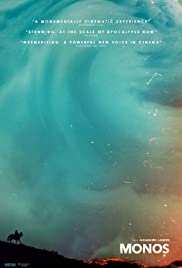
MONOS
Colombia, 2019, 104 minutes, Colour.
Sophia Buenaventura, Julian Giraldo, Karen Quintero, Laura Castrillon, Deiby Rueda, Paul Cubides, Sneider Castro, Moises Arias, Julianne Nicholson, Wilson Salazar.
Directed by Alejandro Landes.
As the audience watches a group of children at the opening of Monos, eight of them, blindfold, playing football, trying to score goals, then seeing them lined up, being drilled, military-like, thoughts about child soldiers and children being exploited by the military readily come to mind. And, with the group of eight, being drilled by a dwarf leader, strict precision, demanding physical exercises, then his departure and their suddenly being let loose and behaving like undisciplined teenagers, perhaps many will think of William Golding’s Lord of the Flies.
And this is not wrong, especially as the scenario unfolds, the interactions of these children with each other, in the war context, their holding a hostage, some battle sequences, and the youngest of the group, nicknamed Smurf, tied up and facing the pig’s head, shown in close-up.
There is some magnificent photography, mountain vistas, then a descent into the lush jungle, rivers and falls.
There is no explicit explanation about the war situation. The group of children are stationed at an outpost, experience an attack, and then have to set up headquarters down-mountain in the jungle. They are guarding a hostage, an American engineer, played by Julianne Nicholson. She is made to participate at times in the activities, photographed with a newspaper to authenticate her capture, then her attempts to escape.
The children are identified visually at first, then by their nicknames which range from Wolf, Dog, Bigfoot, Boom-boom, and three girls, Lady, the young Swede, and the unexpectedly named Rambo. We get to know them, some of them rather well, a crisis after they are given a cow to provide them with milk and in some mayhem, it is shot, and the leader, Wolf, made to take responsibility – even to his death. At times, they have to act like adults. At times, they don’t know how to act as adults.
On the narrative level, the audience is plunged into an unfamiliar world, asked to think about contemporary uprisings and revolutions, especially in Latin America, to think about the exploitation of children in war and the consequences for them.
Towards the end of the film, there are some hints of ordinariness, a couple with children playing, their watching the television, a slight item about making jelly babies in Germany – and then tragedy. There is a helicopter rescue, flying in over the city – and, rather than an ending, the narrative just stopping at a crucial moment, challenging the audience to reflect on what they have seen and felt, and what they might anticipate for the future.
(Mono is Spanish for monkey – and Monos, is Spanish slaying for “how cute!�.)
1. Title? The Spanish for monkeys? Spanish Spain, “how cute�?
2. The Latin American setting, Colombia, the mountain scenery, the jungle scenery, rivers and falls? Beauty and violence? The musical score?
3. The references to Lord of the Flies? Group of youngsters? On their own? Discipline? Falling apart? In the context of war? Child soldiers? The exploitation of children? The consequences?
4. The introduction to the group, the dwarf leader, his demands, discipline? Military? The exercises, drills, the soccer with blindfolds, the exercise regime? Permissions to speak? Permission for Wolf and Lady to be partners? The role of the group in war? Child soldiers, preteen, teenagers? Holding the fort? The Doctora as prisoner? From America? Engineer? Speaking English, Spanish?
5. The leader, the drills, his going back to headquarters, radio connection, his orders?
6. Doctora, her presence, capture, treatment, alone, the food, the group guarding her? The photos, her reading the paper, information from her captors? Her continued participation with the group, their making demands on her, her wanting to escape?
7. The range of personalities in the group, Wolf as leader, his relationship with Lady, his responsibilities? The issue of the cow, the mayhem and Dog shooting the cow, Wolf having to take responsibility, digging the hole, covering it? His death? Lady and her role with the group, her age, sexual experience, the further relationship with Bigfoot?
8. Bigfoot, small, leadership and responsibility, erratic mood, the reactions of the others in the group, Dog, warrior, slow-witted? Boom-boom as the favoured soldier? Smurf, his age, imposing responsibilities on him? Rambo, a girl, warrior? Swede, young, her keeping guard on the Doctora, fears at the invasion, taking refuge with the doctor, the doctor’s response?
9. The issue of the cow, the milking, responsibilities, the cow shot dead, dragged, cut up for meat, the group eating?
10. The aftermath of the drill, not supervised, behaviour falling apart, childish, reckless? Drinking? Some mayhem?
11. The invasion, the battle, black-and-white night photography? The effect on the group?
12. The transition to the jungle, setting up the centre, Bigfoot in charge? The place of the doctor, her attempts to escape, in the river, on the bridge, captured again, her being chained? Smurf and his being tied up, wanting to leave with her?
13. The children painting themselves, echoes of Lord of the Flies, the pig’s head and its standing facing Smurf?
14. Rambo, her treatment by a Bigfoot, her escape, down the river and the falls? Bigfoot pursuing her? Her finding the children playing, the husband and wife watching the television, the slight programs, the making of jelly babies in Germany? The information about the uprising? The invasion, the shooting of the parents, the children hiding? Rambo, the boat, later in the flood, face down on the sand, the helicopter rescue?
15. The doctor, news of her being sighted, escape?
16. The fate of the other children? The continuation of the war? The exhortation of the child soldiers? Rambo sitting in the helicopter and the military asking for orders as to how to deal with her? Her future?
17. The group of children as metaphor for contemporary society?